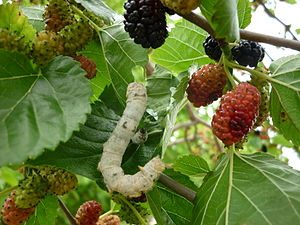Mulberry is cultivated mainly for silk production. Mulberry is considered an indigenous plant of China. Mulberry is a perennial plant. But it has a shorter lifespan than other older trees. It is widely grown in India, Uttar Pradesh, Madhya Pradesh, Bihar, Jharkhand, Himachal, Haryana and Punjab.
Along with silkworms, mulberry is also grown as a fruit. Its fruits are used in many ways. In which juice, jelly and candy are made from fruit juice. Its fruits also have medicinal properties. For this reason, it is also used to make many kinds of medicines.
Mulberry trees grow well in the rainy season at normal temperatures. Its seedlings cannot grow in winter. So summer is perfect for the growth of its trees. Its trees have a general need for rain. And the pH of the soil for its cultivation. The value should also be normal.
If you are also thinking of cultivating it, today we are going to give you complete information about its cultivation.
Suitable soil
Mulberry cultivation requires fertile soil with proper drainage. This crop can be grown even in black smooth soil with proper drainage of water. The pH of the soil for its cultivation. The value should be between 6 and 7.
Climate and temperature
Temperate climate is best for mulberry cultivation. Its seedlings cannot grow in winter. And winter frosts are bad for it. So summer and monsoon are good for its trees. During this time the plants grow well. Its fruits ripen in summer. Its trees need normal rainfall.
Its seedlings require a temperature of 20 to 25 degrees for early growth. After that, when the plant is fully grown, its plants can tolerate a maximum temperature of 40 and a minimum of 4 degrees. But if the minimum temperature stays too long, the plants get damaged.
Improved varieties
There are several types of mulberry that are grown in different places.
Victory 1
This variety is also called V-1. This is going to be a mulberry hybrid. Whose S-30 and Ber. It is made from a hybrid of C-776. Its leaves are smooth, shiny and rough in shape. The branches and stalks of this species look brown. Plants of this species are considered best for silkworm rearing.
S36
The stem of this species of mulberry plant is brownish pink in color. Plants of this species are useful for rearing young silkworms. Its leaves look smooth and shiny without tips. Which looks greenish yellow. Its leaves contain normal amounts of moisture and nutrients. Trees of this species are of normal height.
Bear
This is a mulberry hybrid, which was created in the year 2000. These types of plants are fast growing. Which spread in small sizes. The leaves of this type of plant are large without tips. Whose color appears dark green. And the branches of this type of plant are pinkish brown.
RC1

This variety of mulberry is also called resource limit 1. This mulberry variety was created in 2005. Trees of this species grow very fast. The branches of this type of plant are pink in color. The leaves of this type of plant are glossy with angles and thick in shape. Whose color appears dark green.
G2
The mulberry variety was bred in 2003 by cross breeding of M. multicollis and S34. The leaves of this species are smooth, shiny and large in size. Whose color appears dark green. Plants of this species are suitable for silkworm rearing.
There are many more types. Which are planted in different places for silk production.
Farm preparation
Mulberry seedlings, once planted, yield for many years. Before planting its seedlings in the field, destroy the remnants of old crops in the field and plow the field well by running palau in the field. After two days plow the field two to three times. After plowing with cultivator, the soil should be loosened by running rotavator in the field. Once the soil is well drained, the soil should be leveled by threshing in the field. So that there is no need to face the problem of water storage in the field during the rainy season.
After the field is prepared, pits are made in the field. Each pit should be spaced about 3 meters apart when making these pits. When making pits, line them up. In the meantime, the distance between each line should be about two and a half to three meters. Once the pits are formed, organic and chemical fertilizers are mixed in the soil to fill the pits. These pits are prepared about a month before planting.
Transplanting seedlings
Silk plants are formed through roots, twigs and seeds. To prepare seedlings by seed, its seeds are processed and grown in a pro-tray in the nursery. They are then developed by giving them proper amount of nutrients. When the seedlings are fully grown, they are uprooted and planted in the field.
The seedlings are transplanted in the nursery to make seedlings from roots and twigs. When cutting them, the length of the branches should be about half a foot. To prepare the seedlings, the branches are dipped in the usual hormones and planted in rows at a distance of about 6 inches from the nursery. After transplanting in the nursery, they should be given proper amount of nutrients. Through which plants grow. In the nursery, when the seedlings are 6 months old, they are planted in a pit prepared in the field.
Time and method of cultivation

Mulberry seedlings are planted in the pits prepared in the field. When transplanting, another small pit is made in the middle of these pits and nursery seedlings are planted in it. After planting in pits, cover the stem well with one inch of soil.
Mulberry seedlings should be planted in the field during most of the rainy season. In the meantime, it is advisable to plant them in June or July. Because the weather is pleasant during this time. Therefore, planting trees at this time does not affect the germination of seedlings and also promotes good growth of the plants.
Irrigation of plants
Mulberry trees need more irrigation in the beginning. Its plants have a general need for water during the winter season. In the meantime water the plants at intervals of 15 days. Its seedlings need more irrigation during the summer season. Therefore, during the summer season, water its plants once a week. And in the rainy season it is advisable to water the seedlings as required. Full grown mulberry trees require regular irrigation.
Fertilizer quantity
Mulberry cultivation requires more fertilizer than usual. Initially when preparing the pits for its cultivation, 15 to 20 kg of old manure and about 100 g of NPK chemical fertilizer should be put in each pit. Fill the pits with soil. The plants should be given this fertilizer for about three to four years.
When the tree is five years old, it should be fertilized. Full-grown seedlings should be given 25 kg of organic manure and 1 kg of chemical fertilizer every year. This helps in better growth of plants.
Weed control
In mulberry cultivation, weed control is done by herbicides only. Mulching should be done lightly at the beginning. So that the tree will not be harmed in any way. The first weeding of seedlings should be done about 20 days after planting in the field. It is sufficient to remove five to seven seedlings in a year.
Plant care
After planting mulberry seedlings in the field, take good care of them. If no seedlings grow after planting in the field, the space is filled by replacing it with another seedling.
When the mulberry is fully grown after planting in the field, the diseased and dried branches should be pruned. As a result, new branches are formed in the trees. On which fresh leaves grow well.
Extra income
Mulberry trees are fully developed two to three years after planting in the field. In the meantime, the farmers can grow vegetables, spices and medicinal crops in the remaining space of the field. Therefore, farmers will continue to get produce from their land. And they will not have to face any kind of financial problems.
Plant diseases and their prevention
Mulberry trees are prone to many diseases. Causing a lot of damage to its plants and leaves. Who need to be taken care of at the right time.
White spot disease
White spot disease in mulberry trees is a bacterial disease. When the disease occurs, white spots appear on the lower surface of the leaves. Its size increases as the disease progresses. As the incidence of the disease increases, the leaves of the trees turn yellow and fall prematurely. This creates difficulties in rearing silkworms. Sulfax 80 WP should be sprayed on the plants in appropriate quantity to control the disease.
Stem borer disease
Insect infestation of stem borer disease in mulberry trees. Insect larvae of this disease make holes in the stems and branches of trees and destroy them by eating them from inside. This stops the growth of the plant. And when the disease progresses, the whole plant is destroyed. To prevent this disease, the right amount of Chloropyrifos should be placed in the pores visible on the stalk and it should be covered with cotton or clay.
Bark-eating caterpillars

Mulberry caterpillars are an insect-borne disease. The caterpillars of this disease eat and weaken the bark and stalk of the tree. This stops the growth of the plant. Monocrotophos or methyl parathion should be sprayed on the plants in appropriate quantity to control the disease.
Leaves burnt
In mulberry trees, the effect of leaf blight is more pronounced with the change of seasons. The disease causes the leaves to dry out and turn yellow. As the disease progresses, all the leaves gradually dry out and fall off. This stops the growth of the plant. To prevent this disease, Baviston should be sprayed on the plants in appropriate quantity.
Leprosy
In mulberry trees the effect of kungi disease is seen on the leaves of the tree. When the disease starts, reddish brown spots appear on the leaves of the tree. As the disease progresses, the leaves turn yellow. And after a while they separate from the trees. Proper spraying of Bavistin or Blitox should be done on the plants to control the disease.
Harvest Harvest
Mulberry is grown mainly for leaves. Which is used in silkworm rearing. Silkworms use their leaves as food. Therefore, its leaves must contain nutrients. For which his plants should be given more fertilizer. After its leaves are cut off, it is cut and prepared for the food of silkworms.
The leaves can also be used to make organic manure after eating silkworms. Mulberry leaves should be picked about 20 to 25 days after fertilization. In one hectare, its fully grown plants produce 8 to 10 thousand kg of leaves annually. Of which 800 to 900 dfl. Insects can be reared.
In addition to leaves, mulberry is also grown for fruit production. Its fruits look dark red when ripe. After breaking it, collect it and sell it in the market. To break the fruit, move a large cloth under the tree, so that the ripe fruit falls off. After picking the fruit, wash it with cold water and send it to market.
Income and profit
Mulberry trees are planted for its leaf use. From which silk is made. For this reason, farmers can earn a lot of money by cultivating silkworms. Apart from this, farmers get good income by selling its fruits in the market. Farmers can get silk production from silkworms three to four times a year.







